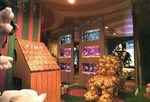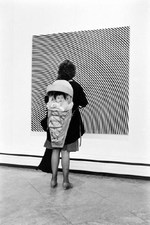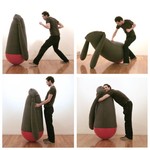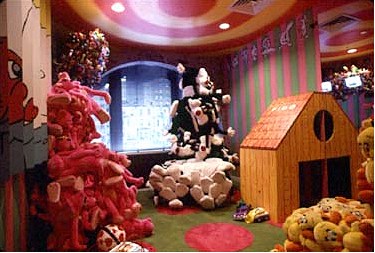
Gary Panter was creative director of one of the most groundbreaking children's TV shows in a generation PeeWee's Playhouse. On the heels of that success, he also designed a children's playroom for Ian Schrager & Philippe Starck's Paramount Hotel in Times Square. Because Panter's art and illustration garners so much attention, an offbeat project like a hotel playroom apparently doesn't come up in most interviews. An interview Panter did with John Kelly for The Comics Journal in 2003 had the most detail I could find online:
PANTER: Well, it's kind of like Pee-wee's Playhouse, but it doesn't really have anything in it that Pee-wee's Playhouse had in it, in particular.A hip hotel where we used to hang out back in the day, plus pot-smoking chefs plus chairs made from stuffed animals, plus a pile of DIY potential? Needless to say, I had to know more.KELLY: It has that feeling to it, though?
PANTER: Yeah. It was this crazy, kind of acid drenched environment for the kitchen help to go smoke pot in at night. It was a tiny little bedroom. I was talking to Ian Schraeger, the owner of the hotel, and it sounded like it was going to be this giant place. But you walk in and it was this tiny bedroom. And so I had to make it look big, using mirrors and decorative painting and stuff to make it look really pretty big. I had some sculptural forms made, furniture shapes and had them covered them with stuffed animals. Like take 16 giant Sylvester dolls and eviscerate them and then apply their skins to these forms. Sylvester and Pink Panther and Tweety Bird chairs. TV sets with toys glued all over them and aquariums with toys in them. Bright color schemes. It's a project you could easily do in your house. It would take some money for the decorative paintings, unless you did it yourself, and the sculptures, but that was kind of the idea.
I decided to drop Panter a line, and he graciously responded to a few questions about an interesting project, very much of its time, which has since been dismantled, and which has so far not gotten the attention it deserves. Check out our email conversation after the jump:
Daddy Types: How did you come to do the project in the first place, whose idea was it, and what were they [Schrager? Starck?] initially looking for?
Gary Panter: was contacted by Ian Schrager who was looking to have a day care center, in the Paramount Hotel in NY, somewhat in the mold of Pee-Wee's playhouse.
DT: In The Comics Journal, you mentioned that the room sounded much bigger when Ian Schrager was first talking about it.
GP: The room was extremely small, a bedroom really. I was expecting a bigger room, but it was my job to make the room seem giant and magical to kids or whoever visited that room. I crowded the small space with sculptural furniture, built in aquariums full of toys, had wall mounted TV sets completely swarming with dime-store toys and then used really big mirrors in the corners to make the illusion of more room. Also, if you were a 3 foot tall kid, the room seemed a lot bigger. Unfortunately, at first, people tried to walk through the mirrors, so certain elements had to be rearranged.
 DT: From The Comics Journal: the restaurant staff used the room to get high? Did you hear any other great stories about the playroom in use?
DT: From The Comics Journal: the restaurant staff used the room to get high? Did you hear any other great stories about the playroom in use?
GP: If I said that in the interview, I was speculating that that might have been the case. Stoners will seek psychedelic dungeons. I heard a lot of people tell me that they went there and thought it was cool--no real tales of the room and debauchery or drug taking. It was for kids and their keen little minds.
DT: What were you shooting for? How did you see it in relation to your other work, including Pee-Wee's Playhouse?
GP: That sensibility of a hyper environment of over-amped colors and cultural references was kind of a psychedelic idea or reconfiguring of what we live or play in. There is a really neat book out now called SPACED OUT by Alastair Gordon that recounts and illustrates many of the hippie happenings and head shops, geodesic domes and futuristic experimental environments of the 60s and it illustrates the experimental spirit that is hard to relate about the ever touted 60s. Pop art environments--hippie places. I think that that is still a very fertile place to draw from.
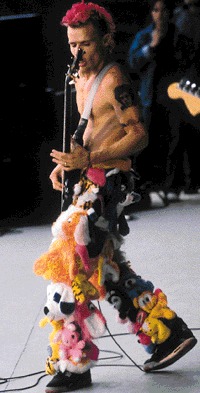 DT: What was there in the room? From the photos on your site, it looks like there were stuffed animal chairs, a playhouse, the aquariums, figures and faces painted along the wall?
DT: What was there in the room? From the photos on your site, it looks like there were stuffed animal chairs, a playhouse, the aquariums, figures and faces painted along the wall?
What's up with those chairs? They're awesome, how did they come about?
GP: I saw a lot of strange aggregate creatures on my LSD freak-outs in the 70s that look a lot like those chairs--like things added to like things.
Each chair had a wooden form underneath and then deconstructed stuffed animals were used to upholster the forms retaining all limbs and protuberances. There were three chairs: Tweety, Sylvester and the Pink Panther.
When I was a baby my father painted Sylvester and Tweety on the wall over my crib. I don't remember that, but it must have made an impression.
However, Mike Kelley totally beat everyone to the aggregate stuffed animal idea with his sculptures in the 80s using thrift shop animals. I saw some stuffed animal pants he made for Flea of the Chili Peppers and let out a groan of BEAT TO THE PUNCH. [image via]
DT: What happened to the playroom? Was it taken out during the 1998 renovation, or some other time? Are there any artifacts or vestiges from it that we should be watching for at Christie's someday?
GP: The sculpture and objects in the room were supposed to come back to me if the room was dismantled. They didn't. I don't know if they are in storage or thrown away. There were some very nicely made sculptures and paintings in there.
Ian Schager seemed to be very happy with the room. It was fun working with him and his staff. Paul Reubens and I are still working on stuff.
DT: It's interesting and very ahead of the curve, I think, that you saw the playroom as having potential to inspire people to do similar things in their own homes. Was that something you had in mind from the beginning? It seems like so many typical kids' play spaces are not designed with that possibility in mind.
GP: Decoration and art and transformation of space usually involve ideas as much as exotic materials. My teenage daughter painted her room to look like a cloud of song lyrics, it is pretty cool. I would encourage people to try new harmless things. If they don't like them they can always paint everything beige again and buy a bigger TV and another jumbo bag of potato chips.
DT: This is fantastic, very interesting, thanks a lot.
GP: Thanks for the publicity for the playroom--it was a fun project. Great site.
The Comics Journal interview: Gary Panter [tcj.com]
Buy Spaced Out: Radical Environments of the Psychedelic Sixties at Amazon [amazon]
watch Flea's pants in the Chili Peppers' video for "Higher Ground" [mtvmusic.com]
Related? dude actually made himself a pair of stuffed animal pants [xmasons.com]
Previously: Lost New York: Gary Panter's Paramount Hotel Playroom

